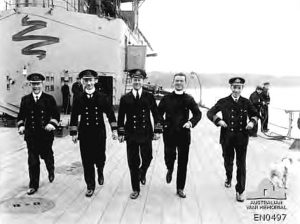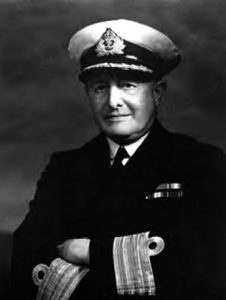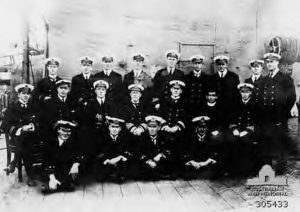- Author
- A.N. Other
- Subjects
- Biographies and personal histories
- Tags
-
- RAN Ships
- None noted.
- Publication
- June 2012 edition of the Naval Historical Review (all rights reserved)
By Richard Gardner
Richard Gardner’s father was a well-known surgeon and a close friend of Surgeon Rear Admiral W. (Billie) Carr. Richard joined the RAN on his 18th birthday in May 1945 and served as an able seaman in HMAS Shropshire on her 1946 Victory Cruise. He recently visited Surigao City to revisit the Shropshire/Arunta Memorial to their participation in the Battle of the Surigao Strait.
Staff Surgeon Alexander Caw, RAN (1879-1924)
The first medical officer appointed to the newly formed RAN was Alexander Caw. His appointment as Staff Surgeon (equivalent to Surgeon Lieutenant Commander) was dated 1 August 1912. Caw was born in England in 1879 and came to Australia at an early age, being educated at St. Peters College and Adelaide University. After graduation, he went to England in 1908 and undertook a course of study, paying particular attention to ship hygiene. He joined the cruiser HMAS Encounter in England on 1 August 1912 as Staff Surgeon, being transferred to the battle-cruiser HMAS Australia on 21 June 1913.
Following the sinking of the German cruiser Emden in October 1914, the German threat in the Pacific Ocean was largely removed and Australia was incorporated into Vice Admiral Beatty’s battle-cruiser squadron based at Scapa Flow. Due to damage sustained in a collision with her sister ship New Zealand, Australia was unable to participate in that mammoth but inconclusive struggle amongst the giants in May 1916, later known to history as the Battle of Jutland. His colleague Surgeon Lieutenant Carr wrote: This doctor was an extremely competent surgeon and successfully carried out a mastoid operation at sea with a set of instruments borrowed largely from the Carpenter. Caw always preferred to do his own operative work on board in preference to sending cases ashore, and removed a considerable number of appendixes later in HMAS Australia with the ship rolling and pitching in the North Sea to such an extent that the operating table had to be lashed to the deck and the patient to the operating table. In spite of these drawbacks, Caw’s operations were invariably successful and the sailors who, at first, viewed these proceedings somewhat dubiously, ultimately preferred to be treated on board. Caw served in Australia throughout the 1914 – 1918 War. He resigned in 1920 and settled in Johannesburg, where he practised as an ENT specialist. He died there in 1924 at the young age of 45.

The Hospital Ship Grantala: Doctors William Horsfall and Alfred Trinca
The Australian Fleet’s first duty in WWI was to escort the Australian Naval and Military Expeditionary Force to German New Guinea, which was captured in September 1914. The RAN’s first and only hospital ship HMAS Grantala accompanied the expedition.
Grantala, a coastal passenger ship, was requisitioned by the RAN on 7 August 1914 and quickly converted into a hospital ship, but being found too small for these duties was decommissioned on 22 December 1914 and returned to her owners. Grantala had a mixed naval and civilian medical staff, the senior surgeon being William Horsfall, who was appointed as Acting Fleet Surgeon to Grantala on 12 August 1914. His naval service was terminated in January 1915.
Alfred Trinca from Melbourne, the son of Italian immigrants, was appointed as a Civilian Surgeon in Grantala from 25 August 1914 on a daily allowance of 35 shillings. His service was terminated on 31 December 1914.
Trinca’s son Gordon became a Fellow of the Royal Australasian College of Surgeons and was a world authority in the field of road trauma.
Surgeon Rear Admiral William James Carr, RAN, CBE, FRACP (1883-1966)
‘Billie’ Carr was born at Thornton-on-Green, Yorkshire. He was educated at Marlborough College and Trinity College, Cambridge. He completed the clinical training for his medical degree at the London Hospital, where he remained as resident medical officer in 1909 – 1910 and then worked as a ship’s doctor on a tramp steamer. In 1911 the newly-formed Royal Australian Navy advertised in Britain for professional men to join the service and Carr enlisted on 9 December 1912. He was posted to the light cruiser HMAS Melbourne with the rank of Surgeon Lieutenant, seeing service in New Guinea (where he was present at the German surrender at Rabaul), the Pacific, North Atlantic and West Indies. In October 1917 he transferred to the battle-cruiser Australia.

In 1920 Carr was posted to the RAN College at Jervis Bay and was promoted to Surgeon Commander in 1924.In 1925 he went on an exchange posting to Haslar, the Royal Naval Hospital at Portsmouth. On his return to Australia in 1927, he was posted to the Flinders Naval Base and he and his wife Leonora (Lenore) settled in at a picturesque house ‘Deep Ghyll’ overlooking Port Phillip Bay on Olivers Hill, Frankston. Referred to by the Melbourne Argus in its social columns as a ‘Beautiful Seaside Home’, the house was situated almost exactly halfway between Carr’s office at Flinders and his Melbourne clubs. In 1932 Carr was appointed Director of Naval Medical Services (DNMS) with the rank of Surgeon Captain. He succeeded Surgeon Commander Leonard Darby, who had won fame as Chief Medical Officer in HMAS Sydney’s epic fight against the German raider Emden off the Cocos-Keeling Islands in 1914. The RAN at this time had been drastically cut following the London Naval Treaty of 1930 limiting the number and tonnage of ships of the world’s navies, coupled with spending cuts during the Great Depression of the late 1920s and early 1930s. In spite of these setbacks, Carr managed to build up a system of naval medical training, including part-time training of young doctors in the Naval Reserve, and had planned the entry of women into the service as nurses. Apart from secondment of RAN doctors to the Royal Naval Hospital Haslar at Portsmouth, Carr arranged for many of them to receive postgraduate Surgeon Captain William Carr RAN training at his old hospital, the London Hospital.
The eight-fold increase in size of the medical services between 1939 and 1945 was handled efficiently, largely due to his planning. He fought to have all hospital ships run and manned by the Navy, but failed to convince the other services, and they were established as Army hospitals. The obituarist in the RACP Journal observed that: Whilst an excellent naval officer and administrator with sound judgement and good sense, Carr was always primarily a doctor and a very human person. He was popular with his subordinates and was sympathetic to the difficulties medical officers faced in a wartime transition from civilian doctoring to military service.
Surgeon Captain ‘Sandy’ Ferguson, RANR, wrote of Carr: I first met Surgeon Captain William Carr in World War 2 when I decided to join the RAN.I was greeted by a short, sturdy man, a perfect gentleman, who made me feel at ease and as one of his ‘sons’. Right through the medical branch, this feeling was pre-eminent, and his obviously humane attitude permeated to every dealing he had with the members of this branch.
As a junior Surgeon Lieutenant, I was posted to an infantry landing ship which was being refitted prior to an assault landing and found that the X-Ray machine on board was in a parlous state. I went to a Sydney supplier and ordered a new one which was duly installed before our ship sailed. I had neglected, in ignorance, to do any of the necessary paperwork, but, it being wartime, the supplier patriotically did as asked. On our way up north, our ship received frantic signals from Navy Office about such an unauthorised action, but on my return to Australia, Carr was kind, gentle and obviously fully understanding when he admonished me face to face. His way of doing things endeared him to all who served under him.
Among Carr’s many responsibilities was the vetting of candidates for entry to the Naval College, now relocated to the Flinders Naval Depot. On 30 November 1933 the Adelaide Advertiser reported that at the Adelaide University 14 candidates from Western Australia and 37 from South Australia were medically examined and interviewed for entry to the College. Candidates were interviewed by Rear Admiral Sarel (Royal Navy), Commander Showers and Mr. Cowan from the Flinders Naval Depot. Surgeon Commander Carr and Surgeon Commander James ‘Jimmie’ Henderson physically examined the boys.
Carr was appointed Honorary Physician to the Governor General continuously from March 1933, and Honorary Surgeon to King George VI from 1940 until his retirement. He was appointed CBE in January 1937 and was also honoured by election as a Fellow of the Royal Australasian College of Physicians. He retired in March 1946 with the rank of Surgeon Rear Admiral, the first RAN officer to reach this rank.
Surgeon Captain Leonard Darby, RAN, CBE (1889 – 1980)
Leonard Darby’s name will forever be associated with the most significant event in the fledgling RAN’s early history – the sinking of the German cruiser Emden off the Cocos-Keeling Islands in the Pacific Ocean on 9 November 1914.
Leonard Darby was born in George Town, Tasmania on 3 January 1899 and attended Church Grammar School, Launceston. He graduated MB BSc from Melbourne University in September 1912. Later in the same month he enlisted in the RAN and was the inaugural appointee to the Naval Hospital at HMAS Cerberus. After a short period of training with the Royal Navy in May 1913 he transferred as the senior surgeon in the new cruiser Sydney. He was supported by an assistant surgeon and Sick Berth Steward 1st Class Thomas Edward Mullins who had served in the Royal Navy from 1900 to 1906. Sydney formed part of the escorting force to the 1st AIF troop convoy crossing the Indian Ocean to Egypt in November 1914.
On the morning of 9 November Sydney was detached to investigate an unidentified ship off the Cocos-Keeling Islands. Engagement with, and destruction of, the German cruiser Emden followed, with the death of four members of Sydney’s crew and the wounding of 13.

Following the action Surgeon Lieutenant Darby wrote a detailed report to his Commanding Officer Captain J.C.T. Glossop, RN, and this report was published by the Government Printer in 1915. The original manuscript is preserved in the Mitchell Library at the NSW Public Library. The report described in detail how the two ship’s surgeons, working in cramped conditions in the stokers’ bathrooms in 105 degrees of heat, treated Sydney’s casualties. Following these tasks, Sydney turned to the rescue and treatment of 45 serious casualties on board Emden. Of its crew of 400, 185 men and 10 officers remained alive. Darby was eventually assisted by one of Emden’s surgeons and the doctor at the Cocos Island Cable Station. Unfortunately, Emden’s second surgeon became delirious and killed himself.
The exemplary medical work carried out by Dr Darby, at the age of 25 and barely a year after he had completed his degree, was testimony to the eminence of the Melbourne University Medical School. Surgeon Darby received no medal for his part in the action, but valuable recognition in the form of accelerated promotion to Staff Surgeon, which would not normally occur until four years after his first appointment as Surgeon.
Darby was an able sportsman and first-class tennis player who won many championships including the Royal Navy Doubles Championship at Roehampton in 1923 paired with another Australian, Engineer Lieutenant Commander L.G. Carr. On the retirement of Staff Surgeon Alexander Caw, Darby thus became the senior surgeon in the RAN and in 1924 became Director General of Medical Services, which post he held until he was succeeded by Surgeon Captain Carr in 1934. The Melbourne Age noted that Darby’s appointment as DGMS …was a further stage in the complete ‘Australianisation’ of the RAN. Surgeon Commander Darby is the first RAN officer to hold this post, which had recently been relinquished by Surgeon Captain G.A.G. Phipps of the Royal Navy who completed a three-year term.
Darby’s final post was Principal Medical Officer of Naval Ships and Establishments in Sydney, which he held from 11 March 1934 until his retirement. This posting involved the oversight of Sydney’s naval hospitals, medical personnel and civilian specialists at visiting warships and hospitals (the Naval wing at the Prince of Wales Repatriation Hospital, Randwick, HMAS Kuttabul at Garden Island, the new hospital HMAS Penguin at Balmoral, and Canonbury at Darling Point during WW II). His medical and representational responsibilities greatly increased upon the arrival of the British Pacific Fleet in 1945.
Darby evidently enjoyed the representational aspects of his appointment, particularly during the war years when his wife was Secretary of the NSW Branch of the annual Red Cross Day Appeal. Among Red Cross gifts to the Navy was a mobile laundry presented in May 1945 that … will wash and dry 20 hospital sheets or 24 personal kits every 25 minutes. On his retirement in 1946, the Darby’s moved to Queensland where he died in 1980; he is buried in the Caloundra Cemetery. The careers of Carr and Darby proceeded in rough parallel, as demonstrated in the following table.
Darby Carr
Date of Birth 3/1/1899 30/1/1883
Appoint Surg Lieut 23/9/1912 9/12/1912
Surg LCDR 1/4/1916 9/12/1918
Surg CMDR 1/4/1922 30/6/1924
DGMS 1/3/1927 22/12/1932
Surg CAPT 31/12/1934 31/12/1934
Hon Surg/Psy GG 1/12/1932 1/3/1933
Hon Surg/PysHM 8/11/1940 8/11/1940
FRACP 10/4/1943
CBE Jun 1939 Jan 1937
Rtd Surg CAPT 24/1/1946
Rtd Surg RADM 7/3/1946
Surgeon Captain Alexander Scott Mackenzie (1886 – 1971)
Apart from Carr and Darby, the only other entries in the 1912 Navy List to continue a naval career were Alexander Scott Mackenzie, from Sale, Victoria, who was born in June 1886 and appointed to the RAN on 9 December 1912, and William Edgar Roberts from Wales, whose date of appointment was New Year’s Day 1913 – these were the last of the 1912 intake. They reached the rank of Surgeon Captain and Surgeon Commander respectively and served in WWII. Surgeon John Stuart Macfarlane served for one year in Encounter and then in Australia until he resigned on 31 January 1914.
Scott Mackenzie was CMO of the Cerberus Hospital during WWII. It is regrettable that so little detail remains of his life as he was obviously a colourful character, loved and respected by all ranks.
In Constant Care Jeppesen recalls a reunion at Richmond Town Hall where Scott Mackenzie was guest of honour. Jeppesen noted that not one of those who had served in the medical branch of the RAN prior to and/or during WWII would have known, or heard of, many of the anecdotes about Scott Mackenzie, Lionel Lockwood and Jimmy Henderson. Scott Mackenzie, in responding to his welcome: …proceeds to display an intimate knowledge of, and care for, all members of the branch whenever and wherever they served. That applied particularly to those alone in small ships at sea or in remote bases in forward areas. Out of uniform and without the bluster and eccentricities, which was more theatrical than natural, Scott was a compassionate man. Scott stayed and mingled with the crowd until quite late. He was last seen disappearing down the long passage again silhouetted against the light, with that unmistakable bearing and gait, with his right arm waving a jaunty farewell.
Surgeon Commander James Henderson, MC (1882 – 1955)
As the life of Surgeon Rear Admiral Lockwood is recounted in another part of this Review the last of the group of medical stalwarts between the two wars is James ‘Jimmie’ Henderson. Jimmie was born on a farm at Barnawartha in northern Victoria in 1882 and studied at Albury Grammar School where he excelled in classics and science. He worked on the family farm until he could afford to move to Melbourne to study medicine. He graduated MB BSc in August 1916 and immediately joined the AIF, which was in desperate need of reinforcements.
Attached to the 12th Battalion, his unit took part in the 1st Australian Division’s attack on the Hindenburg Outpost Line in northern France on 18 September 1918 which was the precursor to the final push to victory in November 1918. During the attack Captain Henderson established his Regimental Aid Post immediately to the rear of the Division and attended to the wounded under heavy shell fire. As the attack progressed he moved forward treating a large number of casualties in the open, showing utter disregard of personal safety. For his services he was awarded the Military Cross.
Following demobilisation in November 1919 James Henderson joined the RAN as a Surgeon Lieutenant and commenced duty at the Flinders Naval Depot. For three years from April 1923 he served in the cruiser HMAS Adelaide, this was followed by a return to Flinders. In 1929 he was lent to the Royal Navy for a year’s service and training. He was promoted to Surgeon Commander in 1932 and at age 55 in July 1937 he retired and was transferred to the Emergency List. Retirement was not to last long as with the outbreak of WWII in September 1939 he was recalled and resumed duties at the Flinders Naval Depot until he finally retired in 1950 at the age of 68. In retirement he continued some duties under contract, such as examining new recruits. He died in Melbourne in 1955.
These early surgeons formed the backbone of the RAN’s permanent medical services. In essence they played a game of ‘musical chairs’, as they were rotated and sometimes re-rotated between the small number of seagoing ships and shore establishments or were seconded to the Royal Navy ‘for service and training’ at the Royal Naval Hospital Haslar, and later to Carr’s old hospital, the London Hospital. They had survived the Depression and most had reached the normal retirement age well before the end of WWII. Their commitment was an inspiration to following generations of naval surgeons.




